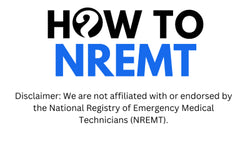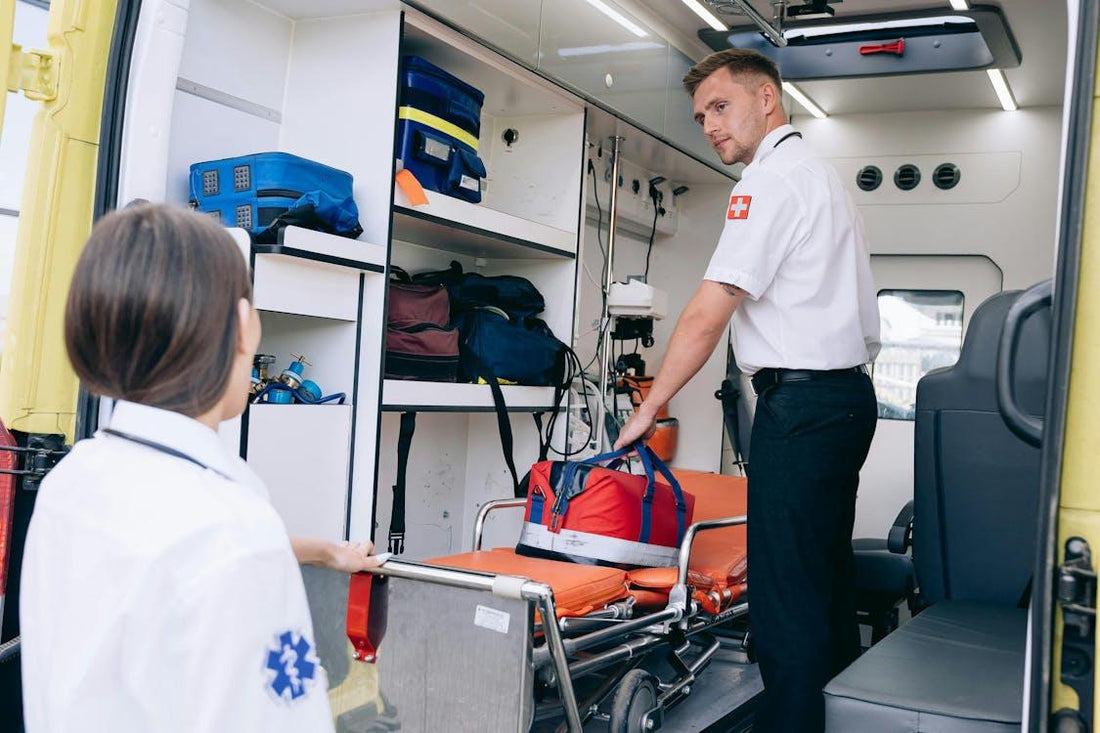The National Registry of Emergency Medical Technicians (NREMT) has fully implemented Clinical Judgment Scenarios into the NREMT cognitive exam for AEMT and Paramedic candidates. These scenarios are now a significant part of the test format and reflect a broader shift toward evaluating real-world decision-making skills rather than simple knowledge recall.
Whether you're a first-time test taker or retesting, understanding NREMT clinical judgment
questions is essential to passing the new exam format—and that’s where How To NREMT comes in. In this guide, we’ll explain what Clinical Judgment Scenarios are, why they matter, how to prepare for them, and how our platform is designed to help you master them.
What Are Clinical Judgment Scenarios?
Clinical Judgment Scenarios are multi-step, technology-enhanced items (TEIs) that simulate real EMS calls. These questions are more than just single-answer multiple-choice. They test your ability to assess patients, form a diagnosis or impression, prioritize interventions, and adjust your plan of care based on evolving information.
Instead of simply asking, "What’s the dose of epinephrine?" a Clinical Judgment Scenario might present a detailed patient case, including vitals, symptoms, and situational context. You might then be asked:
·Which assessment step you perform first
·What treatment is most appropriate
·What would your next action would be if the patient’s condition changes
These questions require critical thinking, prioritization, and sequencing—core components of the NREMT clinical judgment domain.
Why Clinical Judgment Now?
The NREMT’s shift to clinical judgment testing isn’t arbitrary. It’s part of a larger national trend in healthcare education, recognizing that memorizing protocols isn’t enough. EMS professionals must be able to think fast, adapt in the moment, and make patient-centered decisions.
Based on Real EMS Practice
Clinical judgment reflects what EMTs, AEMTs, and Paramedics do every day. EMS providers operate in unpredictable environments. A standardized test must reflect that reality, and these new scenarios do.
Informed by Practice Analyses
Every five years, the NREMT conducts comprehensive Practice Analyses of EMS roles. These analyses revealed that decision-making is one of the most critical—and inconsistently taught—skills in EMS. Adding NREMT clinical judgment scenarios ensures that test-takers are evaluated on what truly matters.
How Clinical Judgment Scenarios Work on the NREMT Exam
Clinical Judgment items are Technology-Enhanced Items (TEIs) that can include:
·Drag-and-Drop: Arrange assessment steps or treatments in the correct order.
·Build-a-List: Select and prioritize a set of actions for a given scenario.
·Checkbox/Multi-Select: Choose all appropriate interventions or observations from a list.
·Clinical Judgment Scenarios: Multi-step cases that start with a dispatch and evolve through assessment findings, treatment decisions, and changes in patient condition.
These TEIs are fully scored and may make up a substantial portion of your NREMT cognitive exam, especially for AEMT and Paramedic candidates beginning July 1, 2024. EMR and EMT (BLS) level exams will include clinical judgment items starting April 7, 2025. To make room for these more complex formats, the NREMT has increased the number of scored questions on the cognitive exam.
Example (Simplified):
You’re dispatched to a 56-year-old male complaining of chest pain. He is diaphoretic and reports a pain level of 8/10. Vitals: BP 98/66, HR 110, RR 20, SpO2 94%.
·Step 1: What is your initial impression?
·Step 2: What is the most appropriate first intervention?
·Step 3: After administering aspirin, the patient begins to vomit and becomes lethargic. What do you do next?
This example shows how a scenario can evolve, requiring judgment and adaptability—skills that are now scored and crucial to passing the NREMT exam.

How To Prepare for NREMT Clinical Judgment Scenarios
Understanding that Clinical Judgment Scenarios are a new testing standard is only the first step. Here's how to actually prepare for them.
1. Learn to Think Like a Medic
Memorization will not get you through clinical judgment questions. You must develop the ability to:
·Recognize patient cues (physical and verbal)
·Determine urgency
·Prioritize steps in patient care
·Adjust your interventions when the scenario changes
This level of thinking takes practice and structured exposure to patient-based situations.
2. Study With Clinical Case Studies
Instead of just reviewing flashcards or simple quiz apps, immerse yourself in full case studies that replicate what you'll see on the test. Look for:
·Multiple inputs (symptoms, vitals, history)
·Shifting conditions (worsening vitals, unresponsiveness, etc.)
·Situational variables (limited resources, location challenges)
3. Use NREMT Exam Practice Tools That Include TEIs
Practicing only multiple-choice questions won’t prepare you for Clinical Judgment Scenarios. You need NREMT exam practice tools that mimic the real structure of the test—including drag-and-drop, list building, and adaptive questioning formats.
4. Simulate Test Conditions
Time matters. Use full-length, timed practice exams that incorporate TEIs and clinical scenarios. This will build stamina and train your brain to think critically under pressure.
How HowTo NREMT Helps You Master Clinical Judgment Scenarios
We’ve built our entire test prep platform to reflect the real NREMT exam experience, including its newest and most challenging components, such as Clinical Judgment Scenarios.
Here’s how we help:
1. Realistic NREMT Clinical Judgment Simulations
Our prep tools feature high-fidelity, scenario-based questions designed to mirror the clinical reasoning expected on the exam. From simulated 911 calls to evolving patient conditions, we walk you through every layer of decision-making.
2. TEI-Rich Practice Exams
We offer full-length NREMT cognitive exam simulations that include TEI formats:
·Drag-and-drop treatment sequences
·Checklist-based assessments
·Prioritization and planning tasks
This ensures you’re not surprised on exam day.
3. Custom Study Plans Focused on Clinical Judgment
Not sure where to begin? Our system assesses your baseline and builds a study roadmap that focuses on your weakest areas—including NREMT clinical judgment skills.
4. One-on-One Coaching With EMS Experts
Our NREMT prep tutor program includes expert guidance from certified EMS instructors who specialize in exam readiness. They’ll walk you through clinical scenarios and explain how to approach them logically.
5. Best NREMT Prep Tools for Every Learning Style
Whether you learn best by watching, doing, or reviewing, we have tools for you:
·Interactive videos
·Scenario breakdowns
·Printable logic maps and flowcharts
·Mobile-friendly apps for on-the-go prep
No matter how you learn, How To NREMT ensures you’re ready to handle the pressure and complexity of modern EMS testing.

Common Mistakes to Avoid With Clinical Judgment Items
Many test-takers struggle not because they don’t know the material but because they aren’t used to thinking through complex patient scenarios. Here are some key mistakes to avoid:
1. Rushing Through Questions
Clinical scenarios are layered. Read them thoroughly, and take time to absorb changing data.
2. Ignoring the Patient’s Story
Many candidates hyperfocus on vitals and miss key verbal clues from the patient, bystanders, or the scene.
3. Using Memorized Algorithms Without Flexibility
Protocols are helpful—but they’re starting points. TEIs may test your ability to deviate from protocol when necessary for patient safety.
4. Overthinking Basic Steps
Don’t forget your fundamentals. Scene safety, ABCs, and reassessment still matter in complex scenarios.
Frequently Asked Questions (FAQ)
1. How early should I start preparing for the NREMT cognitive exam?
Ideally, start preparing at least 6–8 weeks before your test date. Clinical judgment scenarios require deep thinking, not just memorization, so give yourself time to work through case-based questions and practice applying protocols in unfamiliar situations.
2. Can I still take the NREMT if I finished my EMS program a while ago?
Yes, but NREMT has a two-year eligibility window from course completion. If your eligibility has expired, you may need to re-enroll in a state-approved refresher course before retaking the exam.
3. What if my program didn’t focus much on clinical decision-making?
That’s common! Many programs are still transitioning to support the new NREMT Clinical Judgment model. That’s why we built How To NREMT—to bridge the gap with interactive cases, step-by-step scenario coaching, and on-demand prep support that mirrors the new exam style.
4. How do I know if I’m ready to take the exam?
If you can consistently answer scenario-based questions correctly across all six NREMT domains—especially Clinical Judgment—and feel comfortable working under timed conditions, you're likely ready. Our mock exams and readiness diagnostics at How To NREMT help verify when it’s time to book your test.
5. How many times can I retake the NREMT exam?
You can attempt the exam up to six times in total. After three failed attempts, the NREMT requires you to complete additional remedial education before testing again. Failing to pass after six attempts requires re-enrollment in an entire EMS course.
6. How is How To NREMT different from other study apps?
Most apps focus on outdated multiple-choice questions. How To NREMT is built for the 2024+ exams, incorporating Clinical Judgment, TEIs, and domain-specific review. We offer:
·Dynamic case studies with branching outcomes
·Real NREMT cognitive exam simulations
·Customized tutoring sessions focused on your weak spots
·Tools for building not just knowledgebut confidence
Mastering the Future of EMS Testing
The inclusion of NREMT clinical judgment scenarios in the updated NREMT exam represents a shift toward smarter, more practice-ready certification. These questions don’t just ask what you know—they test how you think.

With the right strategy and support, you can rise to meet this challenge. How To NREMT offers everything you need to build confidence, sharpen decision-making, and pass your exam with flying colors.
Whether you need practice exams, TEI simulations, or 1-on-1 coaching from seasoned NREMT tutors, we are your all-in-one solution for the best NREMT prep.Want a more focused approach? Join our 7- or 14-day NREMT Boot Camp—live and online—to fast-track your readiness before test day.
Let us help you train smarter, test better, and think like the provider you’re meant to be.Become a member today.

